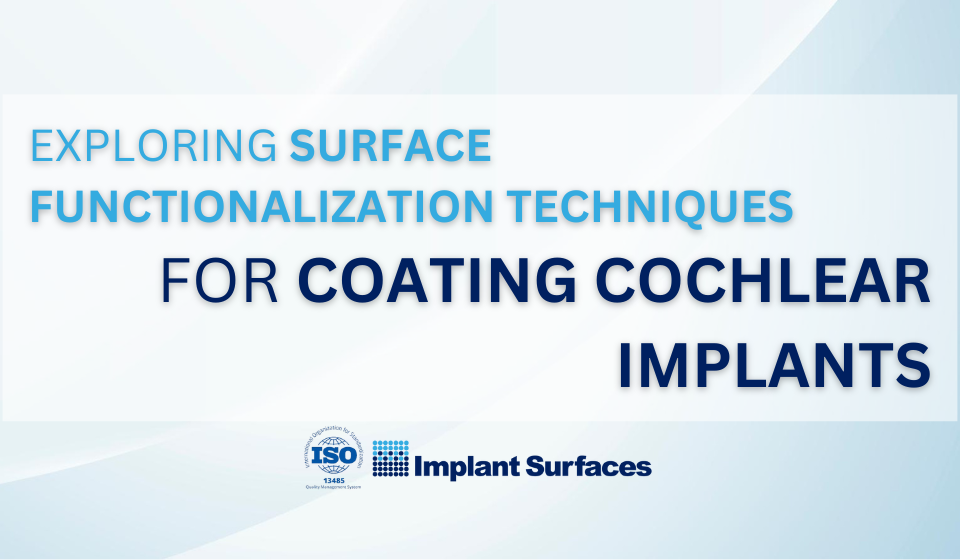
Unlocking Dental Implant Integration: The Power of Plasma Surface Treatment
April 25, 2024
Advancing Orthopedic Implants: Harnessing Silver Nanoparticle Coatings for Enhanced Antibacterial Properties
April 27, 2024In the realm of cranial implantology, advancements in surface coatings play a pivotal role in improving implant performance and patient outcomes. The design and selection of coatings are influenced by various biomechanical factors aimed at optimizing integration, stability, and long-term durability. Let’s delve into the biomechanical considerations that guide the development of coatings for cranial implants.
Understanding Cranial Implant Biomechanics
Cranial implants are utilized in a variety of clinical scenarios, including cranial defect repair, craniofacial reconstruction, and augmentation procedures. These implants must withstand biomechanical forces exerted by surrounding tissues, including bone, muscle, and skin, while providing structural support and aesthetic restoration.
Optimizing Coating Properties
Coatings for cranial implants are designed to enhance osseointegration, minimize inflammatory responses, and prevent bacterial colonization. Key coating properties, such as surface topography, chemistry, and roughness, are tailored to promote favorable interactions with the surrounding tissues.
Surface Topography and Osseointegration
The topographical features of coatings significantly influence osseointegration, the process by which bone integrates with the implant surface. Nanostructured coatings with microporous architectures mimic the natural bone matrix, facilitating bone ingrowth and implant stability. Surface roughness also plays a crucial role in promoting osteoblast adhesion and proliferation, ultimately leading to improved implant fixation and long-term success.
Surface Chemistry and Biocompatibility
The chemical composition of coatings dictates their biocompatibility and cellular responses at the implant-tissue interface. Bioactive coatings, such as hydroxyapatite and calcium phosphate, enhance bone cell activity and mineralization, fostering rapid bone apposition and integration. Additionally, functional groups on the coating surface can modulate cellular adhesion and proliferation, promoting soft tissue integration and reducing the risk of inflammatory reactions.
Mechanical Stability and Durability
Cranial implants are subjected to mechanical loads during daily activities, making mechanical stability and durability critical considerations in coating design. Coatings must withstand bending, torsional, and compressive forces without delamination or fracture. Advanced coating techniques, such as plasma spraying and physical vapor deposition, offer enhanced adhesion and mechanical strength, ensuring long-lasting implant performance.
Preventing Infection and Complications
Infection remains a significant concern in cranial implant surgery, necessitating coatings with antimicrobial properties. Coatings can be modified to release antimicrobial agents or incorporate nanoparticles with inherent antibacterial properties, preventing bacterial colonization and reducing the risk of implant-related infections.
Future Directions in Coating Design
Advancements in material science and nanotechnology continue to drive innovation in coating design for cranial implants. Bioactive coatings with controlled drug release capabilities, smart coatings responsive to physiological stimuli, and personalized coatings tailored to patient-specific requirements represent exciting avenues for future research and development.
Conclusion
Biomechanical considerations are paramount in the design of coatings for cranial implants, ensuring optimal performance, integration, and long-term stability. By harnessing the principles of surface engineering, material science, and biomechanics, clinicians and researchers can develop coatings that enhance implant biocompatibility, mechanical properties, and resistance to infection, ultimately improving patient outcomes and quality of life.
By addressing biomechanical considerations in coating design, Implant Surfaces remains at the forefront of innovation in cranial implantology, advancing the field and shaping the future of patient care.




